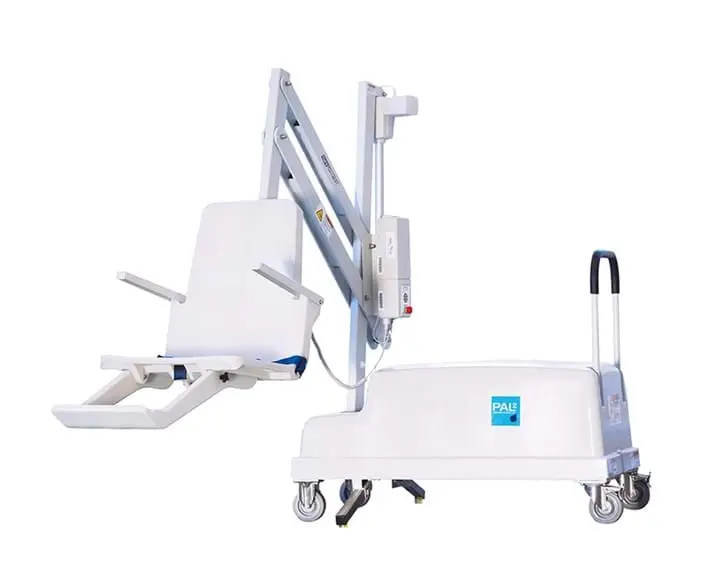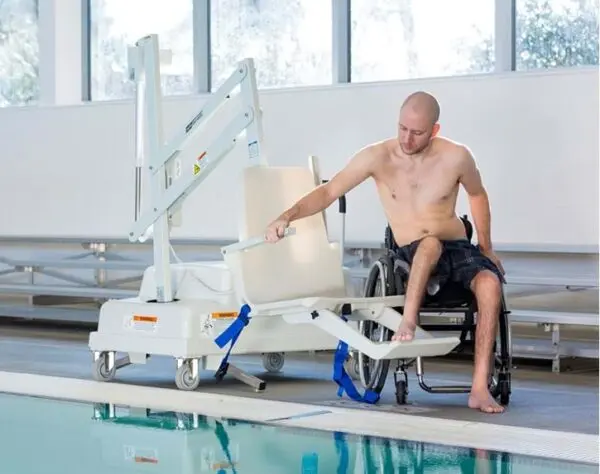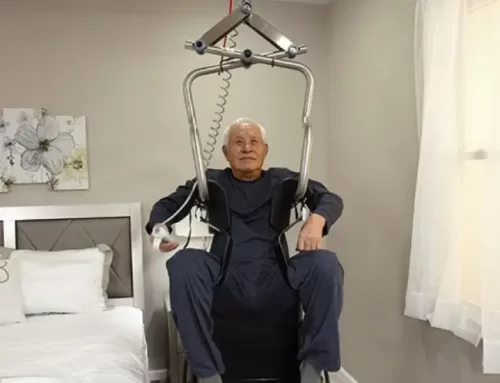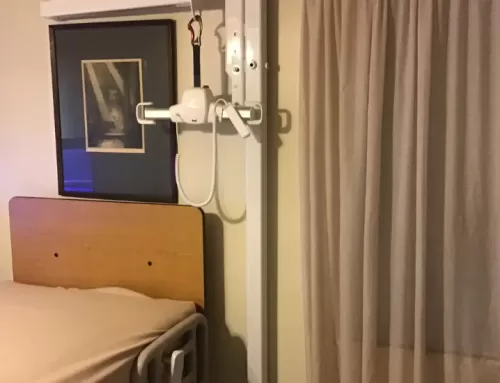Swimming may appear to be an easy activity for most people. However, people with weaker swimming abilities may be putting themselves in danger just by going near water because of their conditions. Fortunately, there are specialized pool lifts available that help people enter and exit the pool or spa while maintaining safety and security. The problem is that there are tons of pool lifts available on the market. How to choose a handicap pool lift from all these options?
The most important considerations when choosing a handicap pool lift are its disability support, weight capacity, and lift range. Also significant is the assessment of the power source, battery life, and compatibility with different pool types. User-friendly controls, durability, and maintenance requirements should not be overlooked while working within a budget.
In this article, we will discuss all these considerations further with some additional tips. By the end of it, you’ll be able to choose the best possible pool lift for you or a loved one.
What Is a Handicap Pool Lift?
A handicap pool lift is a safety-built seat with a passive restraint. It helps individuals who have trouble moving to get in and out of a pool or spa safely using a lift arm. Seat materials can range from mesh to plastic.
The pool lifts are adaptable and have options for headrests, footrests, armrests, and back support. They can also run on batteries, water-powered hydraulics, or a hand crank. You can operate the lift either manually or with a handheld remote.
Why Is It Important to Pick the Right Lift?
No ordinary swimming pool lift will do the work when it comes to meeting your or your loved one’s specific requirements for getting in and out of the pool. That’s why it’s extremely important to pick the right lift. Here are more reasons why the choice is so necessary:
- Different lifts will work in slightly different ways, and some may give more individual support than others. So, you might miss out on the best pool lift if you do not look for it and just pick the first one that looks like it will work.
- You or your loved one can stay comfortable, avoid getting hurt, and enjoy being outside more if you choose the right pool lift that fits your requirements.
That’s why it’s advisable not to rush through shopping and to take as much time as needed.

How to Choose a Handicap Pool Lift: Buying Guide
Taking time to make the right choice for the pool lift is necessary. However, if you don’t have proper guidelines, time will simply be wasted. Here is the best possible guide to choosing a handicap pool lift to make your choice a piece of cake:
-
Disability Support Design
The difficulty of entering and exiting a body of water varies from person to person. This means you should not have to settle for a generic seat design. The design of some pool lifts takes pressure off the legs, while others use extra support features like headrests to help people with neck and back pain. All of these products are different, but they are all made to provide a certain type of physical support. It is key to find the one that supports you or your loved ones the most.
-
Weight Capacity and Lift Range
When looking to purchase a pool lift, weight capacity should be one of your top priorities. The lift should be able to securely support both users and their mobility aids or equipment. Pool lifts come in a range of models, and some can lift as much as 600 pounds!
The lift’s capacity to raise and lower the user is defined by its lift range, which is another valuable consideration. Pick a lift whose height adjustment capability covers the pool’s depth. Otherwise, the user will have to climb the lift higher than the pool’s entry point.
-
Power Source and Battery Life
You can find pool lifts that run on electricity, batteries, or hydraulics. Consider your or your relative’s needs and budget carefully before deciding on a power source.
The most common kind of pool lift is a battery-operated model, which avoids the need to have an electrical outlet close to the pool. Before you buy, think about how long the battery will last and how long it will take to charge it.
-
Type of Pool
Make sure you know exactly what kind of water you intend to use the pool lift on. While these are most commonly seen in residential pools, they can also be useful for accessing spas and ponds. For some of these uses, certain models will work better than others. Thus, the most vital thing to consider when choosing a lift is the location where you intend to use it frequently.
-
Ease of Use and Control Options
Try to find a pool lift that does not need additional manpower to operate and has simple, easily accessible controls. Swivel seats and adjustable footrests are extra features that some pool lifts offer, making them easier to use.
-
Durability and Maintenance Requirements
Pool lifts are subjected to severe conditions, so picking one that can endure water, chemicals, and sunlight is significant. Wrap the lift in a cover if you are storing it outside. Keep in mind that the lift will need regular cleaning, upkeep, and possible repairs.
-
Cost and Budget Considerations
A pool lift can cost anywhere from a few thousand to tens of thousands of dollars, so it is wise to think about your budget before buying one. The price of the lift might go up depending on its features, weight capacity, and durability.

Additional Considerations Before Buying a Handicap Pool Lift
The above guide will be enough to help you purchase the exact pool lift you need. However, there are some more complimentary considerations that can turn out to be game-changing. Let’s look at them for a more secure purchase:
-
Consider Personal Support Needs
As we said earlier, different pool lifts excel at providing different physical advantages. Hence, if you don’t know exactly what your needs are, picking the right pool won’t be possible. For that reason, you should check your health and mobility or that of your loved one for whom you’ll get the lift.
You can either consult a medical professional for advice on the best kind of lift or try to pinpoint the trouble spots. Doing so will help you or a loved one zero in on a product that meets their specific comfort needs.
-
Understand How You’ll Mount Your Lift
Keeping the installation process of the pool lifts in mind during the purchase can make things a whole lot easier. Here’s why.
Pool lifts need plenty of support to stay upright and safely carry the user’s weight while they work. So, to make it fit in with the flow of your property, you must know where you want to install the lift and how you want to mount it.
Installing it permanently on your pool deck is one option, while a portable one gives you more flexibility. It should work for whatever pool experience you or your loved one are after. You can choose the best pool lift based on your preferences afterward.
Most Common Types of Pool Lifts
We have already seen that the lift types can vary based on the installation, power source, and the location where the lift will be used. However, getting a better grip on all these types will make your decision-making even firmer. So, let’s discuss some of the common types of pool lifts:
-
Fixed Pool Lifts
For facilities that require a long-term solution, fixed pool lifts are a great choice. These lifts are permanently installed on pool decks. They are strong and adaptable, making them great for both home and business use.
-
Portable Pool Lifts
If your home or business has limited space, a portable pool lift is a great, easy-to-transport and install option. Despite having a lower weight capacity, they provide safe support for the majority of users.
-
Spa Pool Lifts
Spa pool lifts are designed for hot tubs and are typically compact and lightweight. They are safe ways to enter and leave and can be fixed in place or moved around.
-
Battery Powered Pool Lifts
Pool lifts that run on rechargeable batteries are common and easy to use. They can hold a lot of weight. It is easy to move and set them up, and they can be stored when not in use. This makes them perfect for small spaces or home use.
-
Manually Operated Pool Lifts
Manual pool lifts are operated by the user or a helper and do not require electricity. These are less expensive and great choices for places without electricity or batteries. However, they might not work for everyone.
-
Water-powered Pool Lifts
Instead of using electricity or batteries, water-powered pool lifts use the force of water to raise and lower the user. Although they are an eco-friendly option, they might not work for everyone and need to be close to a water source.
Conclusion
A handicap pool lift makes it safer for people who have trouble moving around to get into and out of pools or spas. The seats on these lifts are made of different materials and can be customized with things like headrests and footrests. Batteries, hydraulics, or a hand crank are all options for powering them.
Choosing the best lift is all about calculated considerations. You should make sure the lift you choose can hold the recommended weight for safety and comfort. The type of installation and lift design are some more things to think about. Besides, knowledge of individual requirements and lift types helps narrow down the choices.
However, all these considerations and guidelines will be of no use if you can’t find a reliable source to purchase the lift. This is exactly why Call Before You Fall exists. Our goal is to give you the best tools that will make your life safer and more independent. Contact us today to learn about our pool lifts.




